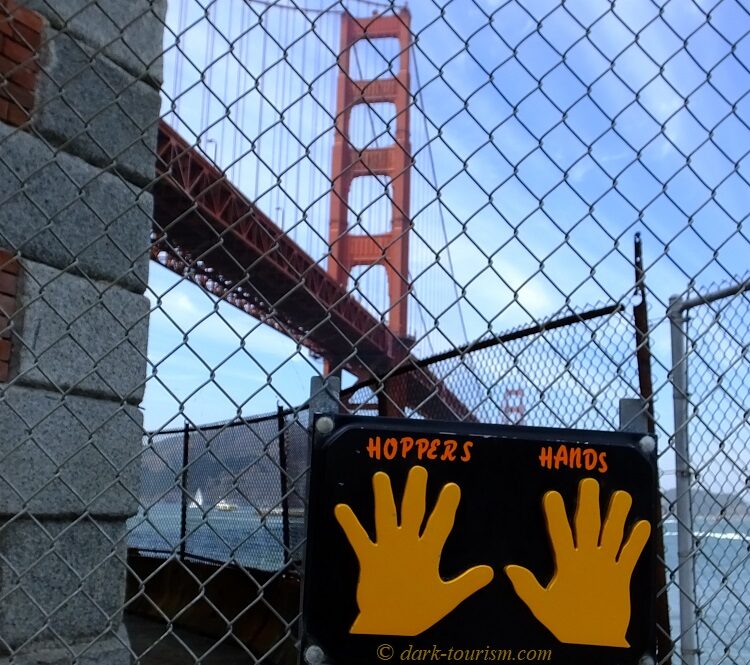| |
|
| ||
|
| |
Hands, Unity, Sobibór & Covid-19 Hello subscribers! The first of the themed posts from our recent poll went up on Thursday: “Dark Tourism & Hands”. There was one vote for this that came in a day late, so I picked this theme first. But I’ll still field the other three over the next few weeks/months as well, as I had promised in the previous Newsletter. The photo featured above, by the way, is another one on the theme of hands, one I forgot to include in last Thursday’s post, so I’m submitting it late here. This was taken at the iconic Golden Gate Bridge in San Francisco, which has a dark history as one of the most “popular” suicide hotspots in the world. The sign in this picture is an allusion to a certain Ken Hopper, a volunteer who has the distinction of having prevented at least 30 suicides by talking (or wrestling) down the potential jumpers. That his name is “Hopper” is of course almost humorous (in a black humour sense). Today is “Tag der deutschen Einheit”, or ‘Day of German Unity’, marking 31 years since the Reunification of Germany and the demise of the GDR, the former Eastern German state. I marked this with a special Blog post too – with a kaleidoscope of photos representing different parts of the country and a little summary of the result of the recent general election in Germany. And on my main website, I finally uploaded the all-new substantial chapter about Sobibór that replaced the seriously outdated old chapter about this significant place. In it I also integrated new information I received last week from the memorial upon my enquiry about a house in the little village just south of the new museum. I had seen that it was marked as “the former house of the commandant of Sobibór” on some photos on Google Maps (and it is also listed as such on the Traces of War website). However, in the Permanent Exhibition Catalogue that I bought at the end of my visit to Sobibór in August it said on page 180 that all surviving buildings were demolished after WWII. So I sent an email to the memorial’s administration and enquired whether that house was indeed a genuine relic or not. Their answer was that yes, it was/is an authentic pre-war structure that once housed the forestry inspectorate and a post office. It was requisitioned by the Nazis when the death camp of Sobibór was established and indeed the first commandant, Franz Stangl, used to live there in 1942. After the war the building was given back to the forestry inspectorate and in the 1970s it was sold into private hands. It is still a private residence but the memorial is hoping to acquire it from the current owner in the future when all the other ongoing archaeological research and building projects at Sobibór are completed. If they manage to do so that would indeed lend further place authenticity to the memorial, but it would be a sensitive element. Yet the integration of a commandant’s house has been done successfully before. Most notably at the former concentration camp of Ravensbrück. Having worked on that all-new Sobibór chapter I also realized that in my book, the short Sobibór entry not only comes with outdated photos of what the site used to look like before the makeover of recent years, it also contains the first factual inaccuracy I’ve found in the book. There it says that the revolt of 14 October 1943 culminated in the escape of ca. 600 prisoners. That’s not quite correct. It was 600 in total that attempted the escape but only half of those actually managed to make it beyond the fence and minefields into the forest around the camp (and of those only about 60 survived until after the war). Finally, I have been alerted to this reaction by Tony Wheeler to this article that speculates about places associated with Covid-19 becoming dark-tourism attractions! Tony Wheeler, best known as the co-founder of the Lonely Planet travel guidebook series, is no stranger to dark tourism himself and has written about places within this concept’s catchment (in particular in his book Dark Lands, and before that also a bit in Bad Lands), though his assertion that visiting “disaster sites […] is what dark tourism is all about” has to be rejected as far too narrow; as the majority of DT sites are not associated with disasters (unless you count human cruelty as “disasters” too). But never mind. Wheeler concludes that while it may be way too early to consider Wuhan in China, where the pandemic first started (presumably at a so-called “wet market”), a dark destination that we should start travelling to, he points out that the UK already has a “national Covid memorial”, namely in London, more precisely the “wall of love” at the Thames’ Albert Embankment, as described in this excellent long article. On my website I haven’t covered Covid in terms of dark tourism yet, but I may have to think about including this memorial wall … if it is here to remain, that is, which at the moment looks not unlikely. So much for this time. Have a good week – and stay safe. Best, Peter
|
|
| |
|
| |||
|
